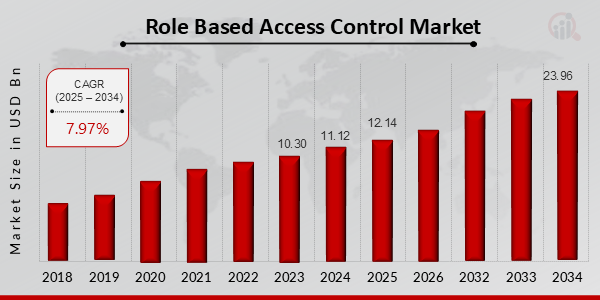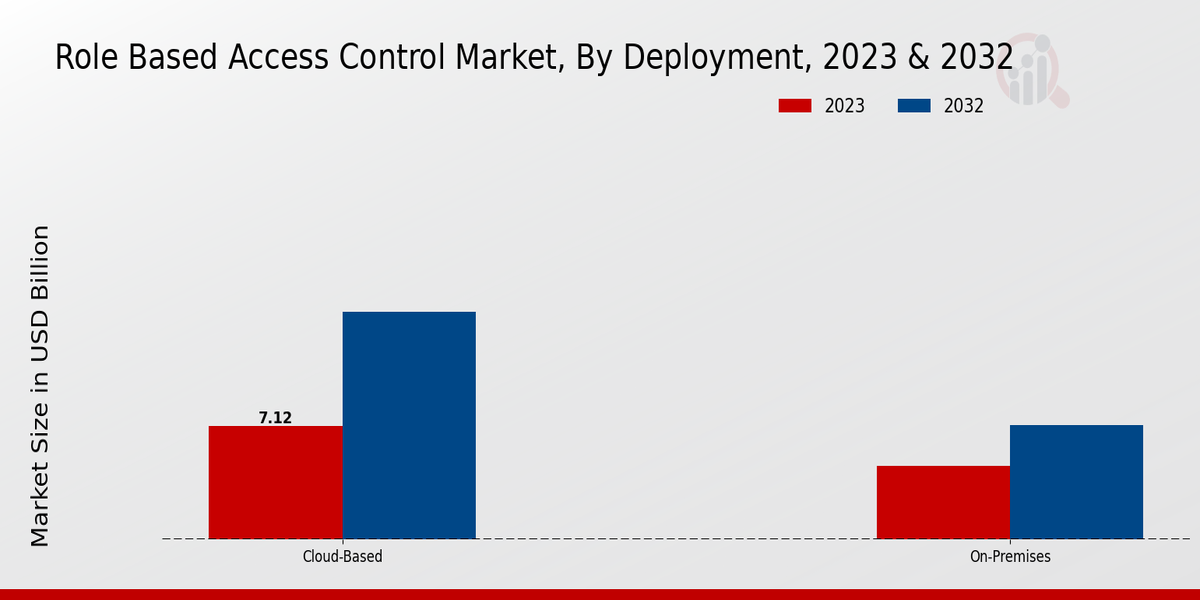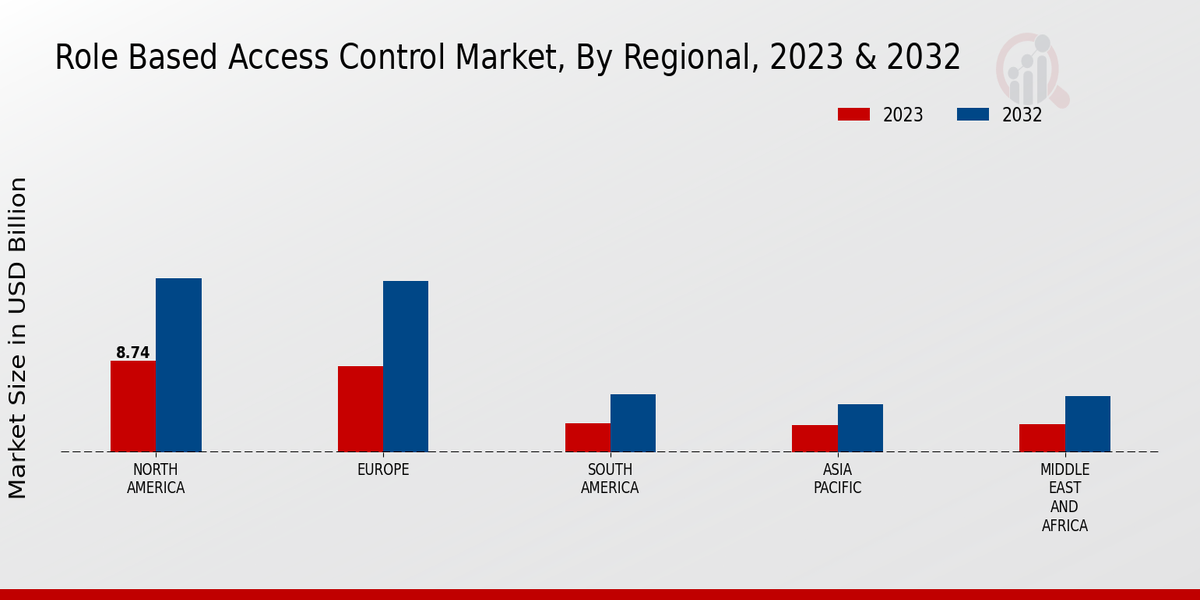Role-Based Access Control Market Overview
Role Based Access Control Market is projected to grow from USD 12.14 Billion in 2025 to USD 23.96 Billion by 2034, exhibiting a compound annual growth rate (CAGR) of 7.97% during the forecast period (2025 - 2034). Additionally, the market size for Role Based Access Control Market was valued at USD 11.12 billion in 2024.
Key Role-Based Access Control Market Trends Highlighted
The factors that drive the Role Based Access Control (RBAC) market growth are the adoption of cloud services, the increasing concern about data protection, and rigid adherence to rules and laws. Businesses are now becoming aware of the merits of RBAC, such as security, ease of management and better performance.
The trend of moving business processes online is further going to increase the need for more secure and efficient RBAC systems. Most companies offering cloud computing services hold and even manipulate delicate information, hence the need to enforce stringent access policies. RBAC systems enable organizations to comply with regulations such as GDPR and HIPAA.
The latest developments in the RBAC market are the deployment of AI and ML to improve security and reduce errors through greater automation. User behavior analytics associated with AI-powered RBAC solutions eliminate threat actors' access to organizations through unusual behavioral patterns of users. RBAC systems are also experiencing the trend of adoption of other systems, such as IAM and PAM.
Figure1: Role-Based Access Control Market, 2025 - 2034 (USD Billion)

Source: Primary Research, Secondary Research, MRFR Database and Analyst Review
Role-Based Access Control Market Drivers
Rising Awareness of Cybersecurity Threats
Nowadays, organizations increasingly realize the threat of data breaches, malware attacks, or unauthorized access to sensitive information that can affect them. Evidently, such an understanding encourages tighter access control solutions. Therefore, the increasing awareness of cybersecurity issues serves as one of the drivers of using role-based access control (RBAC), a pertinent definition of the level of resource access based on the user's role in the organization.
The latter issue is crucial not only for minimizing the threat of data breaches but also for enhancing cybersecurity as a whole. Nowadays, RBAC can be viewed as an integral part of cybersecurity as it allows organizations to prevent unauthorized access to their data and reduce the risk of data breaches, as well as to comply with the legislative requirements. The described tendency is likely to influence the growth of the global RBAC market as the increasing investments in cybersecurity will lead to the necessity to address the issue of improperly managed access.Thus, the growing awareness of cybersecurity threats is expected to be one of the main drivers of the RBAC market in the future.
Growing Adoption of Cloud Computing
Another key driver of growth for the global RBAC market is the increasing adoption of cloud computing. Cloud computing provides organizations with a number of benefits. It can help organizations to manage access to cloud resources securely and efficiently. RBAC can be used to define the level of access that users have to cloud resources, such as data and applications, based on their roles.
This can help to reduce the risk of unauthorized access to sensitive data and applications.The increasing adoption of cloud computing is expected to drive the demand for RBAC solutions in the next few years. More and more organizations are moving their data and applications to the cloud, and they need to implement strong access control measures to protect their data and systems.
Increasing Regulatory Compliance Requirements
Increasing regulatory compliance requirements are also driving the growth of the global RBAC market. Many industries are subject to regulations that require them to implement robust access control measures to protect sensitive data. RBAC can help organizations comply with these regulations by providing a framework for defining and managing user access to data and applications. The increasing regulatory compliance requirements are expected to drive demand for RBAC solutions in the coming years.As more industries are subject to regulations that require them to implement robust access control measures, the demand for RBAC solutions is likely to increase.
Role-Based Access Control Market Segment Insights
Role-Based Access Control Market Deployment Insights
The deployment segment of the Global Role Based Access Control Market comprises cloud-based and on-premises solutions. Cloud-based solutions are gaining traction due to their scalability, cost-effectiveness, and ease of deployment. The growing adoption of cloud computing services is driving the growth of the cloud-based deployment segment. On-premises solutions, on the other hand, offer greater control and customization options, which makes them suitable for organizations with complex security requirements.
The Global Role Based Access Control Market revenue for the cloud-based deployment segment is projected to reach USD 7.12 billion by 2024, growing at a CAGR of 8.2%.The on-premises deployment segment is expected to generate revenue of USD 4.63 billion by 2024, with a CAGR of 6.5%. The market growth for cloud-based solutions is attributed to the increasing adoption of cloud computing services by enterprises. Cloud-based solutions offer several advantages over on-premises solutions, such as lower upfront costs, scalability, and flexibility. Additionally, cloud-based solutions are easier to deploy and manage, which makes them attractive to organizations with limited IT resources.
The on-premises deployment segment is expected to continue to grow, albeit at a slower pace than the cloud-based segment.On-premises solutions offer greater control and customization options, which makes them suitable for organizations with complex security requirements. Additionally, some organizations may be hesitant to migrate their data to the cloud due to security concerns. Overall, the deployment segment of the Global Role Based Access Control Market is expected to grow steadily in the coming years, driven by the increasing adoption of cloud computing services and the growing need for robust access control solutions.
Figure2: Role-Based Access Control Market, By Deployment, 2023 & 2032 (USD billion)

Source: Primary Research, Secondary Research, MRFR Database and Analyst Review
Role-Based Access Control Market Organization Size Insights
Segmentation based on organization size, the Global Role Based Access Control Market has been divided into Small and Medium Enterprises and Large Enterprises. The large enterprises segment is anticipated to have the highest market share in 2023 and is expected to dominate the market over the forecast period. This is due to the growing adoption of RBAC solutions by large enterprises to level up their security barriers and enhance operation efficiency.
Moreover, large enterprises have complex IT ecosystems with a high number of users and resources which makes RBAC the appropriate solution to administer access control and ensure proper compliance with the set internal and external regulatory requirements.Conversely, the SME segment is anticipated to have the highest growth rate over the forecast period due to the fast-growing awareness of RBAC solutions within SMEs and the increasing deployment of cloud-based RBAC solutions to cater to SMEs with cost-effective, scalable solutions.
Role-Based Access Control Market Industry Vertical Insights
The Global Role Based Access Control Market is segmented by industry vertical into healthcare, financial services, government, retail, and manufacturing. Among these segments, healthcare is expected to hold the largest market share in 2023, accounting for 25.4% of the global market revenue. This growth is attributed to the increasing adoption of electronic health records (EHRs) and the need to protect patient data.
The financial services segment is expected to grow at a CAGR of 9.2% during the forecast period, owing to the increasing adoption of RBAC solutions to enhance security and compliance.The government segment is also expected to witness significant growth as governments worldwide are focusing on improving cybersecurity measures. The retail and manufacturing segments are also expected to contribute to the growth of the Global Role Based Access Control Market.
Role-Based Access Control Market Application Insights
The Global Role Based Access Control Market revenue from the Application segment is predicted to grow significantly in the coming years. In 2023, the Authorization Management segment held the largest market share, accounting for nearly 38.2% of the global market. This dominance is attributed to the increasing need for organizations to effectively manage user access and permissions within complex IT environments. Authentication Management is another key segment, expected to register a CAGR of 8.7% during the forecast period.
The growing adoption of cloud-based applications and the need for strong authentication mechanisms are driving the growth of this segment.Data Access Control is also a significant segment, with a projected CAGR of 7.9%. The rising concerns over data privacy and security regulations are fueling the demand for robust data access control solutions. Compliance Management is another important segment, anticipated to grow at a rate of 8.5%. The increasing regulatory landscape and the need for organizations to adhere to compliance mandates are propelling the growth of this segment.
Role-Based Access Control Market Authentication Protocol Insights
The Authentication Protocol segment of the Global Role Based Access Control Market is anticipated to witness substantial growth in the coming years, driven by the rising demand for secure and efficient access control solutions. LDAP (Lightweight Directory Access Protocol) holds a significant market share due to its wide adoption in enterprise environments for user authentication and authorization. SAML (Security Assertion Markup Language) is gaining traction as it enables secure single sign-on (SSO) across multiple applications and domains.
OAuth (Open Authorization) is another widely used protocol for authorizing access to protected resources without sharing passwords.Kerberos is a robust protocol that provides strong authentication and encryption for network services, making it suitable for high-security environments. The Global Role Based Access Control Market for Authentication Protocol is expected to reach a value of USD 4.56 billion by 2024, exhibiting a CAGR of 12.3% during the forecast period.
Role-Based Access Control Market Regional Insights
The Regional segment of the Global Role Based Access Control Market is expected to experience significant growth in the coming years. North America is expected to hold the largest market share, followed by Europe, APAC, South America, and MEA. The growth in North America is attributed to the increasing adoption of cloud-based RBAC solutions and the presence of a large number of enterprises in the region. Europe is also expected to witness significant growth due to the increasing adoption of RBAC solutions in the public sector.
The APAC region is expected to be the fastest-growing region, driven by the increasing adoption of RBAC solutions in the banking, financial services, and insurance (BFSI) sector. South America and MEA are expected to witness moderate growth due to the increasing adoption of RBAC solutions in the government and healthcare sectors.
Figure3: Role-Based Access Control Market, By Regional, 2023 & 2032 (USD billion)

Source: Primary Research, Secondary Research, MRFR Database and Analyst Review
Role-Based Access Control Market Key Players And Competitive Insights
Major players in Role Based Access Control Market industry are continuously striving to maintain their foothold in the market by introducing advanced features in their RBAC solutions. They are also focusing on strategic partnerships and collaborations to strengthen their market position. Leading Role-Based Access Control Market players are investing heavily in research and development to develop innovative products that meet the evolving needs of customers.
Role Based Access Control Market development is being driven by the increasing need for data security and compliance, rising adoption of cloud-based applications, and growing concerns over insider threats. The competitive landscape is expected to remain highly fragmented, with a number of regional players competing with global vendors.One of the leading Role Based Access Control Market players is SailPoint Technologies, Inc.
The company offers a comprehensive suite of RBAC solutions that help organizations manage user access and entitlements across cloud, on-premises, and hybrid environments. SailPoint's solutions are used by a wide range of organizations, including Fortune 500 companies and government agencies. The company has a strong focus on innovation and customer satisfaction, and it is consistently ranked among the top vendors in the RBAC market.A notable competitor in the Role Based Access Control Market is Oracle Corporation.
The company's RBAC solution, Oracle Identity Governance, is a comprehensive platform that provides centralized access management and entitlement analytics. Oracle Identity Governance is used by a large number of organizations worldwide, and it is particularly well-suited for enterprises with complex IT environments. Oracle is a leading provider of enterprise software solutions, and it has a strong track record of innovation and customer support.
Key Companies in the Role Based Access Control Market Include
-
IBM
-
Google
-
Saviynt
-
Micro Focus
-
Ping Identity
-
Microsoft
-
Okta
-
Oracle
-
Thycotic
-
BeyondTrust
-
Axiomatics
-
SAP
-
SailPoint Technologies
-
RSA Security
-
Omada
Role-Based Access Control Market Industry Developments
The global Role-Based Access Control (RBAC) market is projected to reach USD 19.02 billion by 2032, exhibiting a CAGR of 7.97% from 2023 to 2032. RBAC is a security model that restricts user access to system resources based on their assigned roles. The increasing adoption of cloud-based applications and the rising need for data security drive market growth. Additionally, the growing demand for RBAC solutions from various industry verticals, including BFSI, healthcare, and manufacturing, contributes to market expansion. Recent news developments include the launch of new RBAC products by vendors such as Oracle, Microsoft, and IBM. Furthermore, strategic partnerships and acquisitions among market players are expected to shape the competitive landscape in the coming years.
Role-Based Access Control Market Segmentation Insights
Role-Based Access Control Market Deployment Outlook
Role-Based Access Control Market Organization Size Outlook
- Small and Medium Enterprises (SMEs)
- Large Enterprises
Role-Based Access Control Market Industry Vertical Outlook
- Healthcare
- Financial Services
- Government
- Retail
- Manufacturing
Role-Based Access Control Market Application Outlook
- Authorization Management
- Authentication Management
- Data Access Control
- Compliance Management
Role-Based Access Control Market Authentication Protocol Outlook
Role-Based Access Control Market Regional Outlook
- North America
- Europe
- South America
- Asia-Pacific
- Middle East and Africa
| Report Attribute/Metric |
Details |
|
Market Size 2024
|
11.12 (USD Billion)
|
|
Market Size 2025
|
12.14 (USD Billion)
|
|
Market Size 2034
|
23.96 (USD Billion)
|
|
Compound Annual Growth Rate (CAGR)
|
7.97% (2025 - 2034)
|
|
Report Coverage
|
Revenue Forecast, Competitive Landscape, Growth Factors, and Trends
|
|
Base Year
|
2024
|
|
Market Forecast Period
|
2025 - 2034
|
|
Historical Data
|
2019 - 2023
|
|
Market Forecast Units
|
USD Billion
|
| Key Companies Profiled |
IBM, Google, Saviynt, Micro Focus, Ping Identity, Microsoft, Okta, Oracle, Thycotic, BeyondTrust, Axiomatics, SAP, SailPoint Technologies, RSA Security, Omada |
| Segments Covered |
Deployment, Organization Size, Industry Vertical, Application, Authentication Protocol, Regional |
| Key Market Opportunities |
Improved data security Enhanced efficiency and productivity Increased compliance and regulatory adherence Growing demand for cloud-based solutions Emerging IoT opportunities |
| Key Market Dynamics |
Growing adoption of cloud-based RBAC solutions The proliferation of IoT devices heightened security concerns, Increasing demand for advanced authorization Management of stricter compliance regulations |
| Countries Covered |
North America, Europe, APAC, South America, MEA |
Frequently Asked Questions (FAQ) :
The global Role-Based Access Control market size is estimated to be valued at USD 12.14 billion in 2025 and is projected to expand at a CAGR of 7.97% to reach USD 19.02 billion by 2034.
Key growth drivers of the market include the increasing adoption of cloud-based and mobile applications, growing concerns over data security and privacy, and the need for enhanced regulatory compliance.
North America is expected to hold the largest market share due to the presence of major technology companies and the early adoption of advanced security solutions.
Key applications include access management for enterprise applications, cloud-based services, mobile devices, and the Internet of Things (IoT).
Major competitors include Microsoft, IBM, Oracle, SAP, and CA Technologies.
The market is projected to register a CAGR of 7.97% from 2024 to 2032.
Challenges include the complexity of managing access rights, the need for continuous monitoring and auditing, and the risk of unauthorized access.
Emerging trends include the adoption of artificial intelligence (AI) and machine learning (ML) for automated access management, the integration of RBAC with other security solutions, and the growing use of cloud-based RBAC services.
RBAC plays a crucial role in enhancing IT security by providing granular access control, reducing the risk of data breaches, and improving compliance.
Key factors driving adoption include the increasing number of cyber threats, the growing need for data protection, and the adoption of cloud-based applications.

















